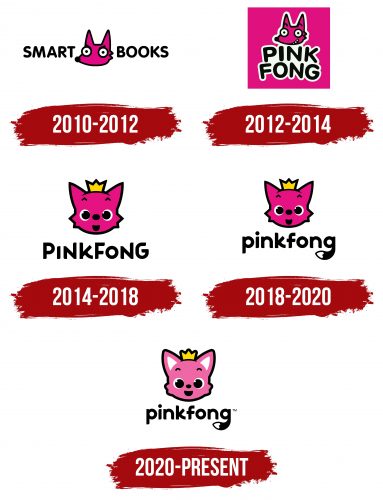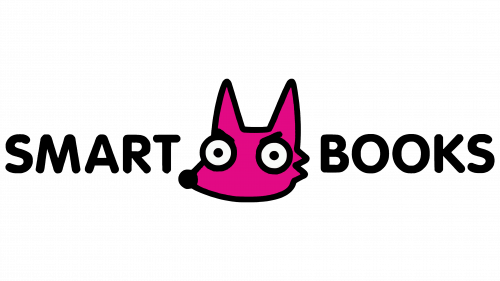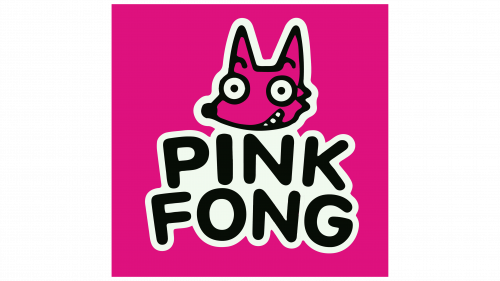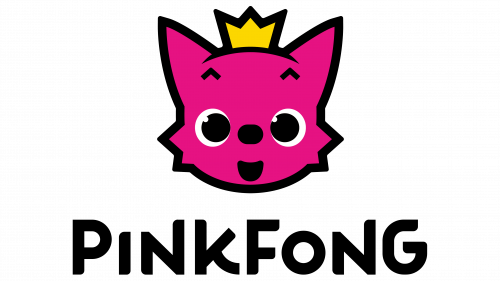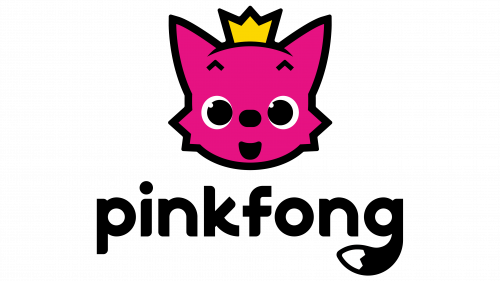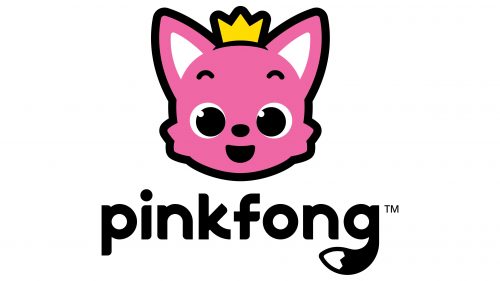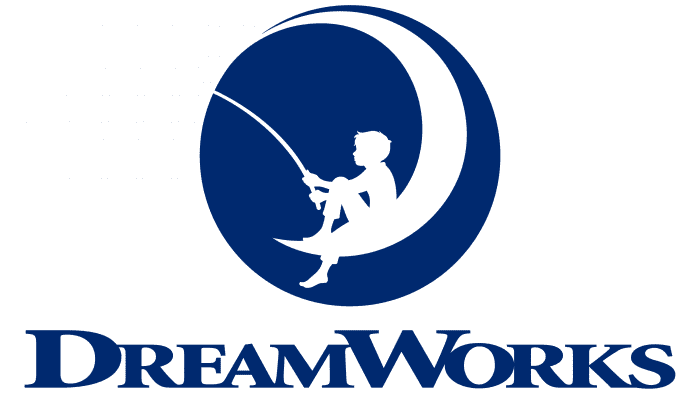The Pinkfong logo instantly captures the attention of a young audience with its bright animated character and playful letter design. Every emblem element looks fun and dynamic, creating an atmosphere of joy and excitement. The cartoon character, a key figure in the logo, symbolizes children’s curiosity and carefree joy in learning. The cheerful, vibrant colors and smooth lines enhance its appeal to little ones, inspiring a desire to play, explore, and learn. The emblem conveys a sense of lightness and adventure, making it a perfect symbol for content aimed at children.
Pinkfong: Brand overview
The history of Pinkfong began in 2010 when Kim Min-seok founded SmartStudy, a South Korean company initially focused on creating educational apps for children. Later, the brand was developed specifically for the company’s child-friendly content.
In 2012, SmartStudy launched its first YouTube channel, “Pinkfong! Kids’ Songs & Stories,” marking the company’s shift toward producing videos for kids, including songs, stories, and educational material.
Between 2013 and 2014, the company experienced rapid growth, expanding its range of animated songs and characters. This period saw increased recognition in South Korea and a growing international audience.
A pivotal year for the company was 2015, as it actively pursued global expansion by launching content in various languages, reaching new viewers worldwide. In 2016, the release of “Baby Shark” became its most successful hit. Based on a classic nursery rhyme, the catchy tune and simple dance moves propelled the song to new heights.
The “Baby Shark” phenomenon exploded in 2017 when the video went viral on YouTube, attracting millions of views and becoming a favorite among children and adults alike. Translations and adaptations in multiple languages followed, further cementing its global appeal.
In 2018, “Baby Shark” was the first children’s song to enter the Billboard Hot 100. This success fueled the brand’s growth into toys, books, and merchandise.
The company continued to thrive in 2019, partnering with Nickelodeon to develop an animated series titled “Baby Shark’s Big Show!” and introducing educational games and apps to expand its offerings.
Despite global challenges in 2020, the “Baby Shark” video surpassed Luis Fonsi’s “Despacito” to become the most-viewed video on YouTube, solidifying the company’s status as a major player in children’s media.
In 2021, the animated series premiered on Nickelodeon, earning positive feedback and expanding the audience further. The same year, the company began experimenting with new formats, such as augmented reality apps and interactive videos.
By 2022, the company had gained worldwide recognition for its educational and entertaining content. It continued introducing new characters and series covering topics like the alphabet and basic science, broadening its appeal.
As of 2023, the company continues to evolve, embracing new technologies and trends in children’s education and entertainment. The focus is now on expanding its presence across streaming platforms, developing interactive formats, and exploring virtual and augmented reality for immersive educational experiences.
Over a decade, the company has grown from a small startup to a global leader in children’s content. Its vibrant characters, catchy music, and educational material demonstrate how timeless children’s songs and stories can be adapted for the digital age to engage audiences worldwide.
Meaning and History
What is Pinkfong?
This well-known children’s entertainment brand gained global popularity through vibrant animations and fun educational songs that captivate young viewers. At the brand’s heart is a charming pink fox mascot that guides children through educational adventures, covering topics from the alphabet to basic science. The brand’s content stands out for its colorful, high-quality animation and catchy tunes that combine learning and entertainment. The company achieved worldwide fame with the viral hit “Baby Shark,” which became a cultural sensation, attracting children’s and adults’ attention. The brand’s success lies in its ability to create content that engages kids and their parents or caregivers, making the learning process enjoyable for the entire family.
2010 – 2012
The brand’s first logo consists of the name and its signature mascot. Initially, the company was called Smart Books Media and was founded as a subsidiary of Samsung Publishing Company Ltd focused on children’s literature. Between the two words of the name is the head of a bright pink fox, chosen intentionally: the fox symbolizes intelligence, cleverness, cunning, and playfulness—qualities that appeal to children. This character became a guide for young ones into the world of knowledge. The fox originally appeared as a dancing character in digital adaptations of children’s songs. The simplicity of the font combined with the fun and unique mascot creates a friendly atmosphere, emphasizing the company’s focus on children’s content.
2012 – 2014
The company’s logo became an app icon as the platform developed and launched children’s games. The central element of the pink square became the image of a little fox with the platform’s name placed on two levels. The image and text are set against a white background, which creates a wide border around the edges, giving the logo a resemblance to a children’s sticker. These stickers are often given to kids as rewards or incentives in preschools, making the logo feel even more friendly and associated with positive experiences and learning.
The fox’s face also changed—now it smiles, and the raised eyebrows, expressing surprise, add a playful touch to the character. While in the first logo, the little fox appeared serious, even stern, it now radiates joy and curiosity, reflecting the fun and discoveries awaiting children on the platform. The fox was named Pinkfong, which combines “Pink” and “Fong.” Though “Fong” isn’t an actual word, it symbolizes an explosion of joy and fun and resonates with “phone,” emphasizing the digital nature of the content. Interestingly, before the final choice of the character’s name, it went through several iterations—Kick-kick, Bebifong, and finally, Fong.
2014 – 2018
The image of the fox cub has been changed, and now its surprised face is directed straight at the viewer. The raised checkmark-shaped eyebrows and slightly open mouth reflect curiosity and surprise—key character traits. The fox cub might be singing, which emphasizes the connection with songs actively uploaded to the platform and hints at the upcoming release of the first version of Baby Shark.
A crown has appeared on the fox cub’s head. The golden attribute highlights its increased status and is tied to the character’s image development. Legends surrounding the character say that it arrived from the planet Staria, a magical star kingdom where it is a prince. This element adds a fairytale-like quality and mystery to the mascot’s story.
For the first time, the platform’s name and the fox cub’s name are written together, but the capital letters at the beginning of each word are preserved, giving the inscription dynamism. Symbols resembling musical notes of different heights echo the phonetic sound of the name, making the logo even more memorable and vibrant.
2018 – 2020
By releasing the Pinkfong Wonderstar cartoon, the logo underwent updates while retaining the recognizable image of the fox cub, which had already become a brand symbol. The name “Pinkfong” is now written in lowercase letters, with the last letter “g” transformed into a small fox tail, giving the emblem playfulness and dynamism. This element visually strengthens the connection to the character, adding a sense of liveliness and fun that attracts the attention of a children’s audience.
The switch to lowercase letters also makes the logo friendlier and more approachable for young children, creating a feeling of warmth and accessibility. This change is tied to the fact that Pinkfong is now the main character’s name and the company creating children’s content. The new design reflects the brand’s evolution, making it even more relatable and understandable to young audiences and parents.
2020 – today
The Pinkfong logo stands out with its bright and friendly design that grabs children’s attention. The central element is a character named Pinkfong, a pink fox cub with a cute smile and large eyes, which has become the brand’s symbol. The fox cub wears a small yellow crown, highlighting its playful and cheerful nature while also indicating the special status of the main character among other figures.
The fox cub’s face is done in pink with a black outline, which adds clarity and sharpness to the image. Large eyes, white ears, and simple black lines create the illusion of a friendly character who always seems ready to play. The smile and expressive eyes convey a sense of joy and openness, which is especially important for capturing the attention of younger children.
Below the fox cub’s image is the word “Pinkfong.” The font is large and rounded and features smooth lines, creating a sense of softness and approachability. This stylistic choice harmonizes with the visual theme of the character — a friendly, fun-loving fox cub. Special emphasis is placed on the letter “g,” which adds a small tail, resembling the fox cub’s tail, tying the text to the brand’s main symbol.

